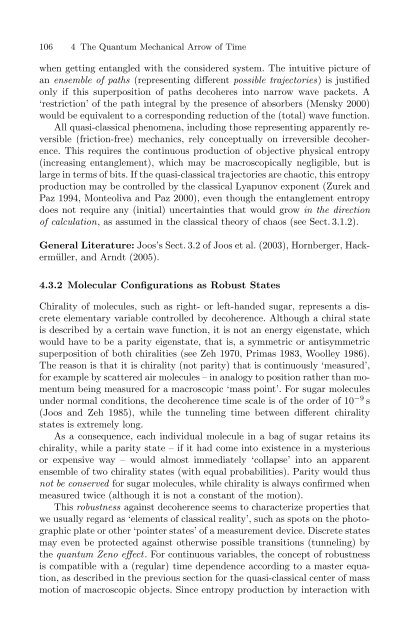The Physical Basis of The Direction of Time (The Frontiers ...
The Physical Basis of The Direction of Time (The Frontiers ...
The Physical Basis of The Direction of Time (The Frontiers ...
You also want an ePaper? Increase the reach of your titles
YUMPU automatically turns print PDFs into web optimized ePapers that Google loves.
106 4 <strong>The</strong> Quantum Mechanical Arrow <strong>of</strong> <strong>Time</strong><br />
when getting entangled with the considered system. <strong>The</strong> intuitive picture <strong>of</strong><br />
an ensemble <strong>of</strong> paths (representing different possible trajectories) is justified<br />
only if this superposition <strong>of</strong> paths decoheres into narrow wave packets. A<br />
‘restriction’ <strong>of</strong> the path integral by the presence <strong>of</strong> absorbers (Mensky 2000)<br />
would be equivalent to a corresponding reduction <strong>of</strong> the (total) wave function.<br />
All quasi-classical phenomena, including those representing apparently reversible<br />
(friction-free) mechanics, rely conceptually on irreversible decoherence.<br />
This requires the continuous production <strong>of</strong> objective physical entropy<br />
(increasing entanglement), which may be macroscopically negligible, but is<br />
large in terms <strong>of</strong> bits. If the quasi-classical trajectories are chaotic, this entropy<br />
production may be controlled by the classical Lyapunov exponent (Zurek and<br />
Paz 1994, Monteoliva and Paz 2000), even though the entanglement entropy<br />
does not require any (initial) uncertainties that would grow in the direction<br />
<strong>of</strong> calculation, as assumed in the classical theory <strong>of</strong> chaos (see Sect. 3.1.2).<br />
General Literature: Joos’s Sect. 3.2 <strong>of</strong> Joos et al. (2003), Hornberger, Hackermüller,<br />
and Arndt (2005).<br />
4.3.2 Molecular Configurations as Robust States<br />
Chirality <strong>of</strong> molecules, such as right- or left-handed sugar, represents a discrete<br />
elementary variable controlled by decoherence. Although a chiral state<br />
is described by a certain wave function, it is not an energy eigenstate, which<br />
would have to be a parity eigenstate, that is, a symmetric or antisymmetric<br />
superposition <strong>of</strong> both chiralities (see Zeh 1970, Primas 1983, Woolley 1986).<br />
<strong>The</strong> reason is that it is chirality (not parity) that is continuously ‘measured’,<br />
for example by scattered air molecules – in analogy to position rather than momentum<br />
being measured for a macroscopic ‘mass point’. For sugar molecules<br />
under normal conditions, the decoherence time scale is <strong>of</strong> the order <strong>of</strong> 10 −9 s<br />
(Joos and Zeh 1985), while the tunneling time between different chirality<br />
states is extremely long.<br />
As a consequence, each individual molecule in a bag <strong>of</strong> sugar retains its<br />
chirality, while a parity state – if it had come into existence in a mysterious<br />
or expensive way – would almost immediately ‘collapse’ into an apparent<br />
ensemble <strong>of</strong> two chirality states (with equal probabilities). Parity would thus<br />
not be conserved for sugar molecules, while chirality is always confirmed when<br />
measured twice (although it is not a constant <strong>of</strong> the motion).<br />
This robustness against decoherence seems to characterize properties that<br />
we usually regard as ‘elements <strong>of</strong> classical reality’, such as spots on the photographic<br />
plate or other ‘pointer states’ <strong>of</strong> a measurement device. Discrete states<br />
may even be protected against otherwise possible transitions (tunneling) by<br />
the quantum Zeno effect. For continuous variables, the concept <strong>of</strong> robustness<br />
is compatible with a (regular) time dependence according to a master equation,<br />
as described in the previous section for the quasi-classical center <strong>of</strong> mass<br />
motion <strong>of</strong> macroscopic objects. Since entropy production by interaction with



![arXiv:1001.0993v1 [hep-ph] 6 Jan 2010](https://img.yumpu.com/51282177/1/190x245/arxiv10010993v1-hep-ph-6-jan-2010.jpg?quality=85)


![arXiv:1008.3907v2 [astro-ph.CO] 1 Nov 2011](https://img.yumpu.com/48909562/1/190x245/arxiv10083907v2-astro-phco-1-nov-2011.jpg?quality=85)








![arXiv:1002.4928v1 [gr-qc] 26 Feb 2010](https://img.yumpu.com/41209516/1/190x245/arxiv10024928v1-gr-qc-26-feb-2010.jpg?quality=85)
![arXiv:1206.2653v1 [astro-ph.CO] 12 Jun 2012](https://img.yumpu.com/39510078/1/190x245/arxiv12062653v1-astro-phco-12-jun-2012.jpg?quality=85)
